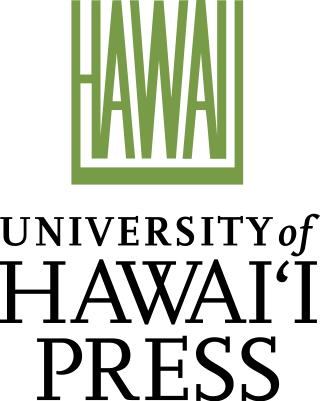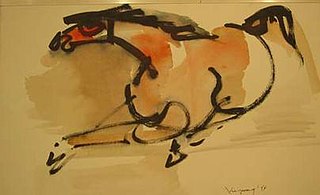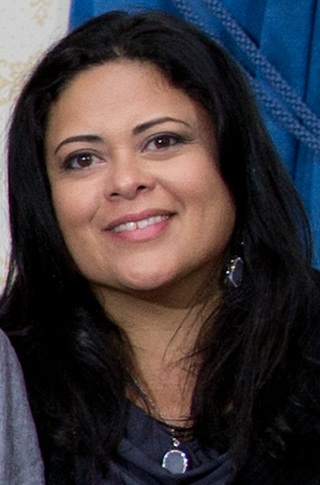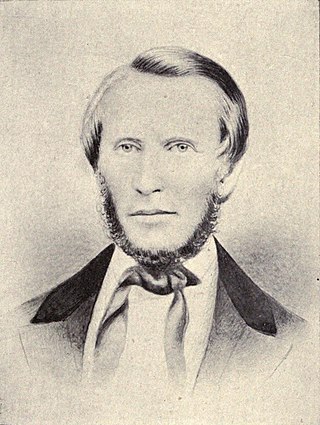Related Research Articles
Hawaiian Pidgin is an English-based creole language spoken in Hawaiʻi. An estimated 600,000 residents of Hawaiʻi speak Hawaiian Pidgin natively and 400,000 speak it as a second language. Although English and Hawaiian are the two official languages of the state of Hawaiʻi, Hawaiian Pidgin is spoken by many Hawaiian residents in everyday conversation and is often used in advertising targeted toward locals in Hawaiʻi. In the Hawaiian language, it is called ʻōlelo paʻi ʻai – "pounding-taro language". Hawaiian Pidgin was first recognized as a language by the U.S. Census Bureau in 2015. However, Hawaiian Pidgin is still thought of as lower status than the Hawaiian and English languages.
The term picture bride refers to the practice in the early 20th century of immigrant workers in Hawaii and the West Coast of the United States and Canada, as well as Brazil selecting brides from their native countries via a matchmaker, who paired bride and groom using only photographs and family recommendations of the possible candidates. This is an abbreviated form of the traditional matchmaking process and is similar in a number of ways to the concept of the mail-order bride.

Puerto Rican migration to Hawaii began when Puerto Rico's sugar industry was devastated by two hurricanes in 1899. The devastation caused a worldwide shortage in sugar and a huge demand for the product from Hawaii. Consequently, Hawaiian sugarcane plantation owners began to recruit the jobless, but experienced, laborers in Puerto Rico.

Valdemar Emil Knudsen was a sugarcane plantation pioneer on west Kauai, Hawaii.

The University of Hawaiʻi Press is a university press that is part of the University of Hawaiʻi.

John Chin Young 容澤泉 (1909–1997) was a painter who was born in Honolulu, Hawaii on March 26, 1909. He was the son of Chinese immigrants and began drawing at the age of eight, stimulated by Chinese calligraphy, which he learned in Chinese language school. Young had his first and only art lessons while a student at President William McKinley High School in Honolulu. Thereafter, his art was entirely self-taught. Young is best known for his Zen-like depictions of horses, paintings of children, and abstractions. Over the years, he acquired an important collection of ancient Asian art, which he donated to the Honolulu Museum of Art and the University of Hawaii at Manoa as the John Young Museum. John Chin Young died in 1997 at the age of 88. His daughter Debbie Young is also a painter residing in Hawaii.

Maya Kasandra Soetoro-Ng is an Indonesian-born American academic, who is a faculty specialist at the Spark M. Matsunaga Institute for Peace and Conflict Resolution, based in the College of Social Sciences at the University of Hawaiʻi at Mānoa. She is also a consultant for the Obama Foundation, working to develop the Asia-Pacific Leaders Program. Formerly a high school history teacher, Soetoro-Ng is the maternal half-sister of Barack Obama, the 44th president of the United States.
The Hamilton Library at the University of Hawaiʻi at Mānoa is the largest research library in the state of Hawaii. The Library serves as a key resource for the flagship Manoa campus as well as the other University of Hawaii system campuses.
Korean immigration to Hawaii has been constant since the early 20th century. There have been two distinct points at which immigration has peaked: the first wave from 1903 to 1949, the second wave from 1950 to 1964. On January 13, 2003, George W. Bush made a special proclamation honoring the Centennial of Korean Immigration to the United States, recognizing the contributions of Korean Americans to the nation.
Samoan literature can be divided into oral and written literatures, in the Samoan language and in English or English translation, and is from the Samoa Islands of independent Samoa and American Samoa, and Samoan writers in diaspora. Samoan as a written language emerged after 1830 when Tahitian and English missionaries from the London Missionary Society, working with Samoan chiefly orators, developed a Latin script based Samoan written language. Before this, there were logologo and tatau but no phonetic written form.
Hawaii is one of the few U.S. states where coffee production is a significant economic industry – coffee is the second largest crop produced there. The 2019–2020 coffee harvest in Hawaii was valued at $102.9 million. As of the 2019-2020 harvest, coffee production in Hawaii accounted for 6,900 acres of land
Ty Pak is a writer and speaker on Korean/Asian American affairs and literature.
The Africans in Hawaii, also known as Pōpolo in the Native Hawaiian language, are a minority of 4.0% of the population including those partially Black, and 2.3% are of African American, Afro-Caribbean, or African descent alone. The Black population is mostly concentrated in the Greater Honolulu area, especially near military installations. There is also a sizeable Cape Verdean American population, and there are some Hispanic people of African descent, namely Puerto Ricans.
Pāʻauhau is an unincorporated community on the island of Hawaiʻi in Hawaiʻi County, Hawaiian Islands. Pāʻauhau is located near the north coast of the island, 2 miles (3.2 km) east-northeast of Honokaʻa.

William Harrison Rice was a missionary teacher from the United States who settled in the Hawaiian Islands and managed an early sugarcane plantation.
People of Filipino descent make up a large and growing part of the State of Hawaii's population. In 2000 they were the third largest ethnic group and represented 22.8% of the population, but more recently, according to the 2010 United States Census data indicates they have become the second largest ethnicity in Hawaii, after Whites.
Most early Asian settlers to the United States went to Hawaii. Most of these early immigrants moved to the islands as laborers to work on the pineapple, coconut, and sugarcane plantations. These early migrants have tended to stay, although a handful returned to their home countries. There has also been recent immigration to Hawaii from more ethnic Asian groups, including the Thai, Indonesian, and the Vietnamese.

The Nippu Jiji, later published as the Hawaii Times, was a Japanese-English language newspaper based in Honolulu, Hawai'i. Established as the Yamato Shimbun by Shintaro Anno in 1895, the paper began as a six-page semi-weekly printed on a lithograph machine, and changed hands four times before being taken over by Yasutaro "Keiho" Soga in 1905. Soga changed the name of the paper to the Nippu Jiji, Japanese for "newspaper for telling timely news," on November 3, 1906, and under his direction the paper was expanded to a twelve-page daily printed on a rotary press with a circulation of 15,000.
Shunzo Sakamaki was a Japanese studies professor at the University of Hawaii. Sakamaki Hall, where the History department at the University of Hawaii is housed, was built after his death and named in his honor.
Jamaica Heolimeleikalani Osorio is a Kanaka Maoli poet, educator, and activist who lives and works in Hawai'i. She is known for her poetry and activism centered on Hawaiian culture and identity.
References
- ↑ Pak's faculty profile
- ↑ Gary Pak: Language of the Geckos and Other Stories
- ↑ Local and Korean roots nourish UH writer Gary Pak
- ↑ amazon book: The Watcher of Waipuna
- ↑ amazon book: A Ricepaper Airplane
- ↑ Language of the Geckos: And Other Stories (The Scott and Laurie Oki Series in Asian American Studies)
- ↑ Oh, Seiwoong (2007). Encyclopedia of Asian-American literature. New York: Facts On File. p. 237. ISBN 978-0816060863.